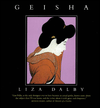For the last twenty years I’ve lived a rather Bohemian existence. Every few years I packed up all my books, and moved on. With each move, more and more of my possessions were left boxed and stashed in storage. In Japan, space was so limited the beautiful pottery I was accumulating remained in wooden boxes, tied with the original brightly-colored braided cords, stacked in the back of a high cupboard.
Unpacking treasures finally into some semblance of a permanent home is pure joy. What would normally be the “family room” in our new house is being transformed into an honest-to-god library. Before leaving for Japan, I had amassed quite a collection of books on different aspects of Japanese life and culture. Many were of the “things to do and see in Japan” variety, while others were full of admonitions, such as “Don’t forget to remove your toilet slippers when leaving the toilet.”
One gem–in a box that I retrieved from Indiana only this July–I had forgotten completely. Rereading it now, I realize that it provided me with my first accurate description of what training in the Japanese koryu would be like–even though at the time I had no notion that I would ever be participating in such an esoteric cultural activity. Geisha, by Liza Dalby, an anthropologist who trained as a geisha in Kyoto for a year, has recently been brought back in print, so you too can benefit from the author’s incredible depth of understanding of a world not so different from that of the koryu.
There’s something, an indefinable “it,” about the koryu that you either get or don’t. It has to do with the interweaving of the social structure of the ryu with Japanese culture at large. It isn’t enough to intellectually “understand” about the complex connectedness; you have to have lived it, breathed it, and, to the extent possible for a non-Japanese (or for that matter Japanese of the younger generations), internalized it. This is what Dalby has succeeded most admirably in doing in the world of the geisha and she has the skill and wit to convey a taste of “it” to the reader.
For example, here’s a lesson that applies equally in both the worlds of the geisha and the koryu. Sakurako is one of the rare young women now pursuing the discipline of the geisha–she is a dancer who has chosen to make her art her life. Dalby comments: “Even when [she] felt she was chided unfairly by an older geisha, Sakurako knew that the proper response in this hierarchical world was to bow her head meekly and accept criticism. Everyone was in a position of seniority, and thus to some extent authority, over her as a new member of the profession and also the community. She often had to bite her tongue to refrain from making excuses or justifying herself. Silent acquiescence was the lesson to be learned [emphasis added]” (p. 215).
Those who’ve trained in the koryu will recognize the feeling. “Hai! Yes, sensei,” to acknowledge hearing the correction (never, never, never, “Hai, wakarimasu. Yes, I understand.” If we understood, our teachers would not need to correct us), biting back the explanation of a sprained toe, or the slick spot on the floor. Silent acquiescence is key in koryu.
In Geisha, Dalby describes an old mama-san, who is not so very different from my own Nitta Sensei, soke of Toda-ha Buko-ryu:
“I thought this seventy-six-year-old lady, familiar with but one milieu in her entire life, had made a remarkable attempt to understand the problems newcomers now face. Some of her cronies drive prospective geisha away with their unyielding attitudes and strict demeanor. By contrast, should one of the young geisha of the Yamabuki commit a faux pas, the proprietress will calmly and kindly explain the matter to her. Perhaps this does not sound remarkable, but explicit explanations are rare in the geisha world. Her willingness to lay out the whys and wherefores of geisha custom is quite enlightened.
“I happened to visit the Yamabuki one afternoon when just such an occasion arose. Tsuzumi, the newest geisha of the house, had had no contact with the geisha world prior to her acceptance at the Yamabuki. She casually mentioned to the proprietress that a Mr. Nakano had given her a nice tip the night before. Mr. Nakano was an old customer of the other geisha of the Yamabuki, and the proprietress knew him as well. The tip was given directly to Tsuzumi–a crisp 10,000-yen note tucked into a specially made fancy paper envelope. The problem was not that the money wasn’t meant for Tsuzumi. It was–but for Tsuzumi as a member of Yamabuki, as opposed to Tsuzumi the new geisha whom Mr. Nakano had just met.
“And the problem was that Tsuzumi had mentioned the matter casually, almost by chance, when she should have made a point to report the favor to the other members of the house. The next time one of the geisha from the Yamabuki happened to meet Mr. Nakano, she would be obliged to thank him for his generosity toward her younger sister. Mr. Nakano would assume that all the Yamabuki geisha knew about the tip and would feel slighted if they did not mention it, even out of ignorance. The perceived lack of manners would reflect badly on the house as a whole. The proprietress later said to me that she never would have thought a geisha would need to be told about this sort of thing.” (p. 207-208)
This is precisely the problem that koryu headmasters face when attempting to educate non-Japanese. Details like these, equally relevant in the koryu, permeate the book. Like the world of sumo, the geisha world preserves important aspects of pre-modern Japanese culture. For those of us trying to understand the koryu, the republication of this book is a great opportunity to gain greater insight. I can’t recommend Geisha highly enough. Read it!
P.S. A couple of other books that provide good cultural background information are Memories of Silk & Straw: A Self-Portrait of Small-Town Japan, and Memoirs of a Geisha (fiction).

